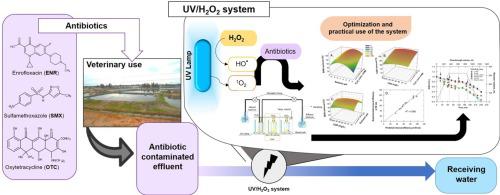Aquacultural Engineering ( IF 3.6 ) Pub Date : 2021-06-13 , DOI: 10.1016/j.aquaeng.2021.102174 K. Jutarvutikul , C. Sakulthaew , C. Chokejaroenrat , A. Pattanateeradetch , S. Imman , N. Suriyachai , T. Satapanajaru , T. Kreetachat

|
Three of the most commonly used veterinary antibiotics—enrofloxacin (ENR), sulfamethoxazole (SMX), and oxytetracycline (OTC)—were chosen as representative antibiotics for UV/H2O2 treatments. The objective was to determine the optimization of UV/H2O2 to remove antibiotics from aquaculture discharge water using response surface methodology. The degradation of the antibiotics was investigated under varying UV/H2O2 conditions in environments with different levels of pH, water matrices, humic acid, and constituent ions. The degradation results demonstrated that increasing the H2O2 dosage facilitated ENR degradation at a neutral pH while facilitating degradation of SMX and OTC at a slightly acidic pH. The optimum removal conditions for ENR, which was used in all influential effect experiments and the contact tank experiments, was obtained at 10 mM H2O2, a pretreated COD of 87.51 mg L−1, and an initial pH of 6.15. Among the tested anions, only the presence of Cl- showed slight positive effects on ENR degradation, due to the generation of secondary active radicals. During the reaction, the hydroxyl radical ( OH) was present at a higher pH while singlet oxygen (1O2) was slightly present at a lower pH. The experimental results from H2O2 sequential addition indicated that freshly added H2O2 could quench the recently generated
OH) was present at a higher pH while singlet oxygen (1O2) was slightly present at a lower pH. The experimental results from H2O2 sequential addition indicated that freshly added H2O2 could quench the recently generated  OH and therefore a high H2O2 concentration with frequent adding was not necessary. Our contact system reduced the ENR concentration in both the effluent reservoir and in the UV irradiation zone. The overall results supported the use of the UV/H2O2 system to treat remnant antibiotics in the discharge water.
OH and therefore a high H2O2 concentration with frequent adding was not necessary. Our contact system reduced the ENR concentration in both the effluent reservoir and in the UV irradiation zone. The overall results supported the use of the UV/H2O2 system to treat remnant antibiotics in the discharge water.
中文翻译:

实际使用响应面方法优化使用 UV/H 2 O 2工艺去除兽用抗生素
三种最常用的兽用抗生素——恩诺沙星 (ENR)、磺胺甲恶唑 (SMX) 和土霉素 (OTC)——被选为 UV/H 2 O 2治疗的代表性抗生素。目的是确定优化 UV/H 2 O 2以使用响应面方法从水产养殖排放水中去除抗生素。在具有不同 pH 值、水基质、腐殖酸和成分离子的环境中,在不同的 UV/H 2 O 2条件下研究了抗生素的降解。降解结果表明,增加 H 2 O 2剂量促进 ENR 在中性 pH 下降解,同时促进 SMX 和 OTC 在微酸性 pH 下降解。用于所有影响效应实验和接触槽实验的 ENR 的最佳去除条件是在 10 mM H 2 O 2、预处理的 COD 为 87.51 mg L -1和初始 pH 值为 6.15 时获得的。在测试的阴离子中,由于二次活性自由基的产生,只有 Cl -的存在对 ENR 降解显示出轻微的积极影响。在反应过程中,羟基自由基 (  OH) 在较高的 pH 值下存在,而单线态氧 ( 1 O 2 ) 在较低的 pH 值下略微存在。H 2的实验结果O 2连续添加表明新添加的H 2 O 2可以淬灭最近生成的
OH) 在较高的 pH 值下存在,而单线态氧 ( 1 O 2 ) 在较低的 pH 值下略微存在。H 2的实验结果O 2连续添加表明新添加的H 2 O 2可以淬灭最近生成的 OH,因此不需要频繁添加的高H 2 O 2浓度。我们的接触系统降低了污水池和紫外线照射区的 ENR 浓度。总体结果支持使用 UV/H 2 O 2系统处理排放水中的残留抗生素。
OH,因此不需要频繁添加的高H 2 O 2浓度。我们的接触系统降低了污水池和紫外线照射区的 ENR 浓度。总体结果支持使用 UV/H 2 O 2系统处理排放水中的残留抗生素。









































 京公网安备 11010802027423号
京公网安备 11010802027423号